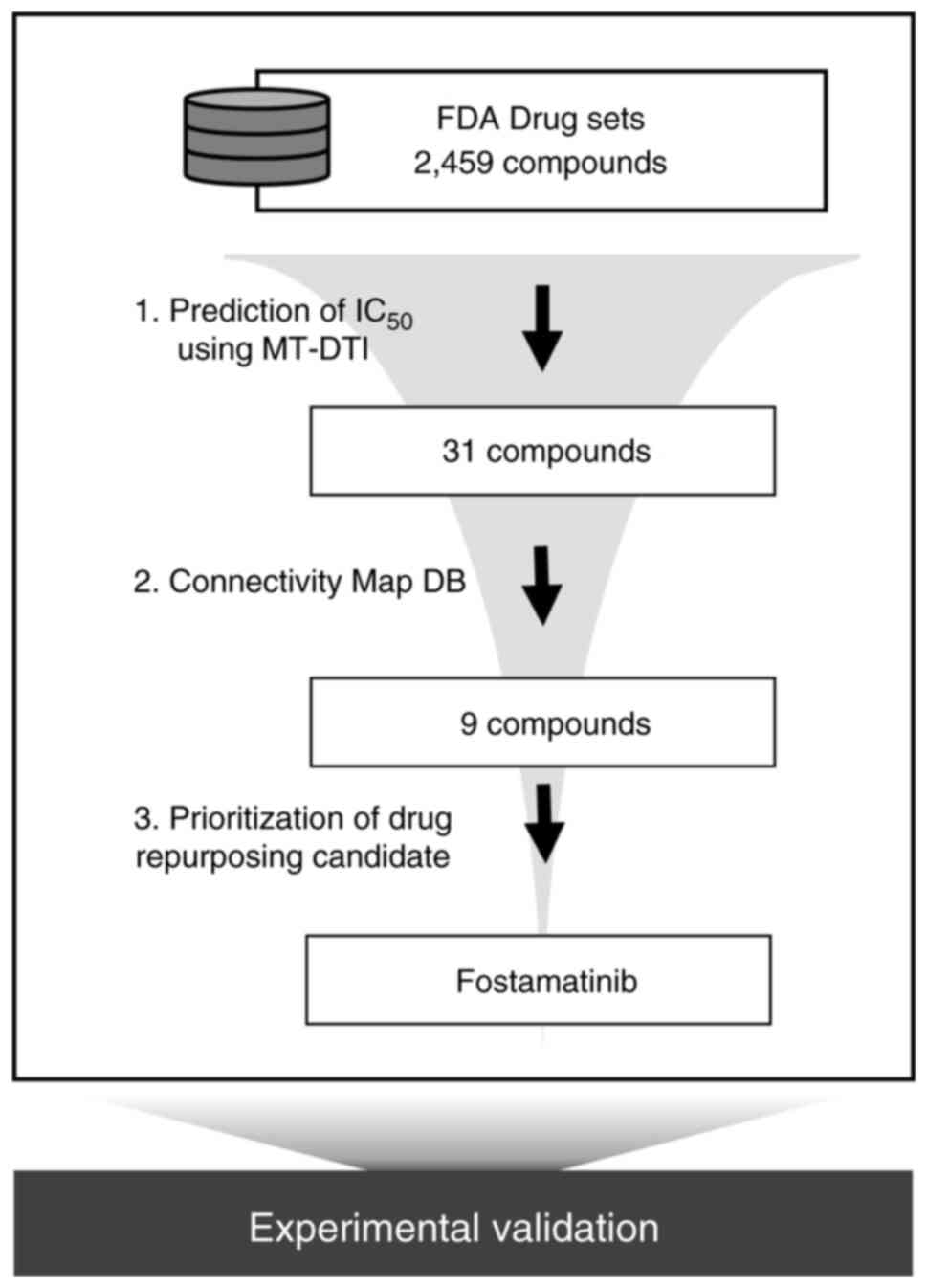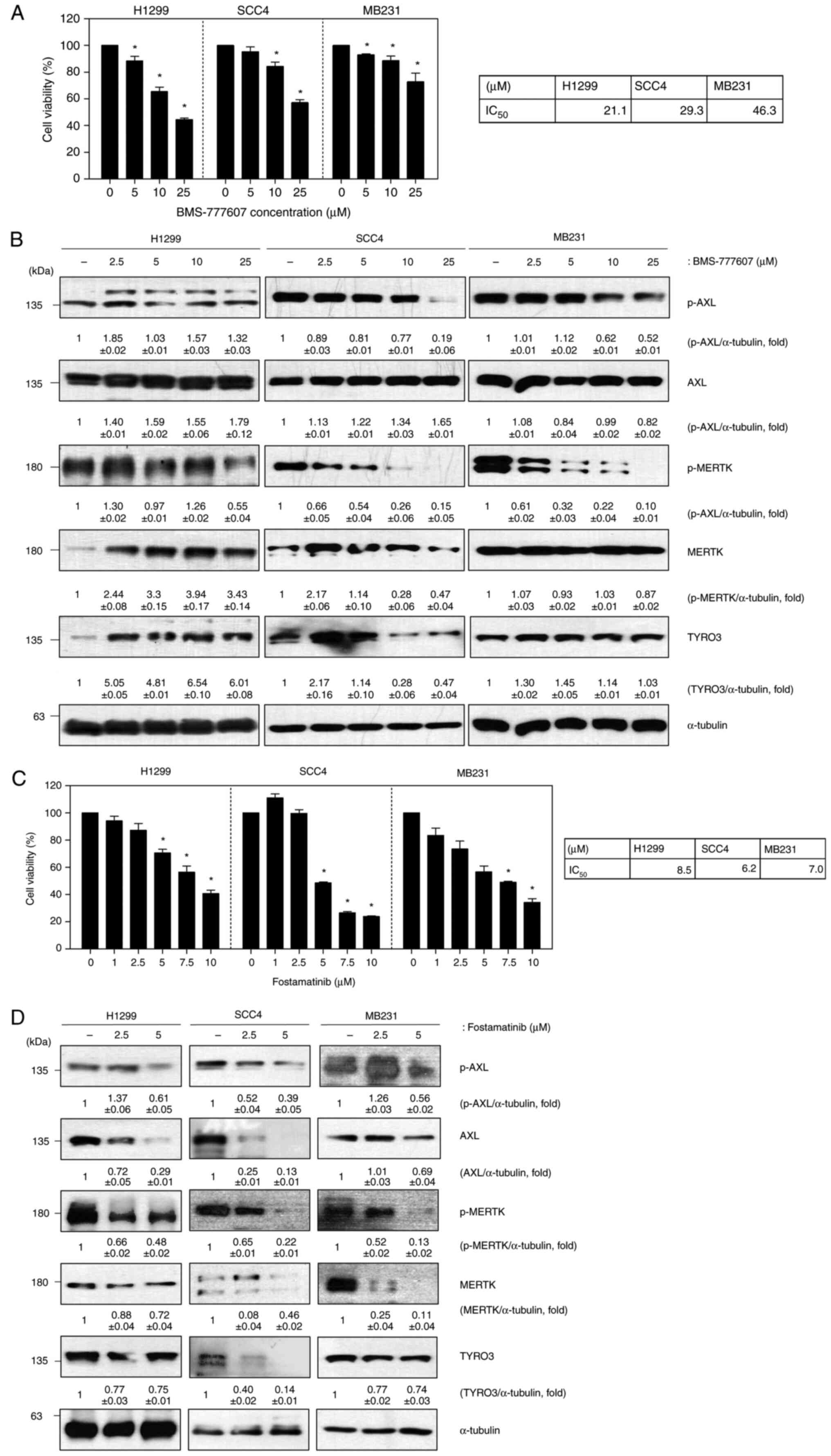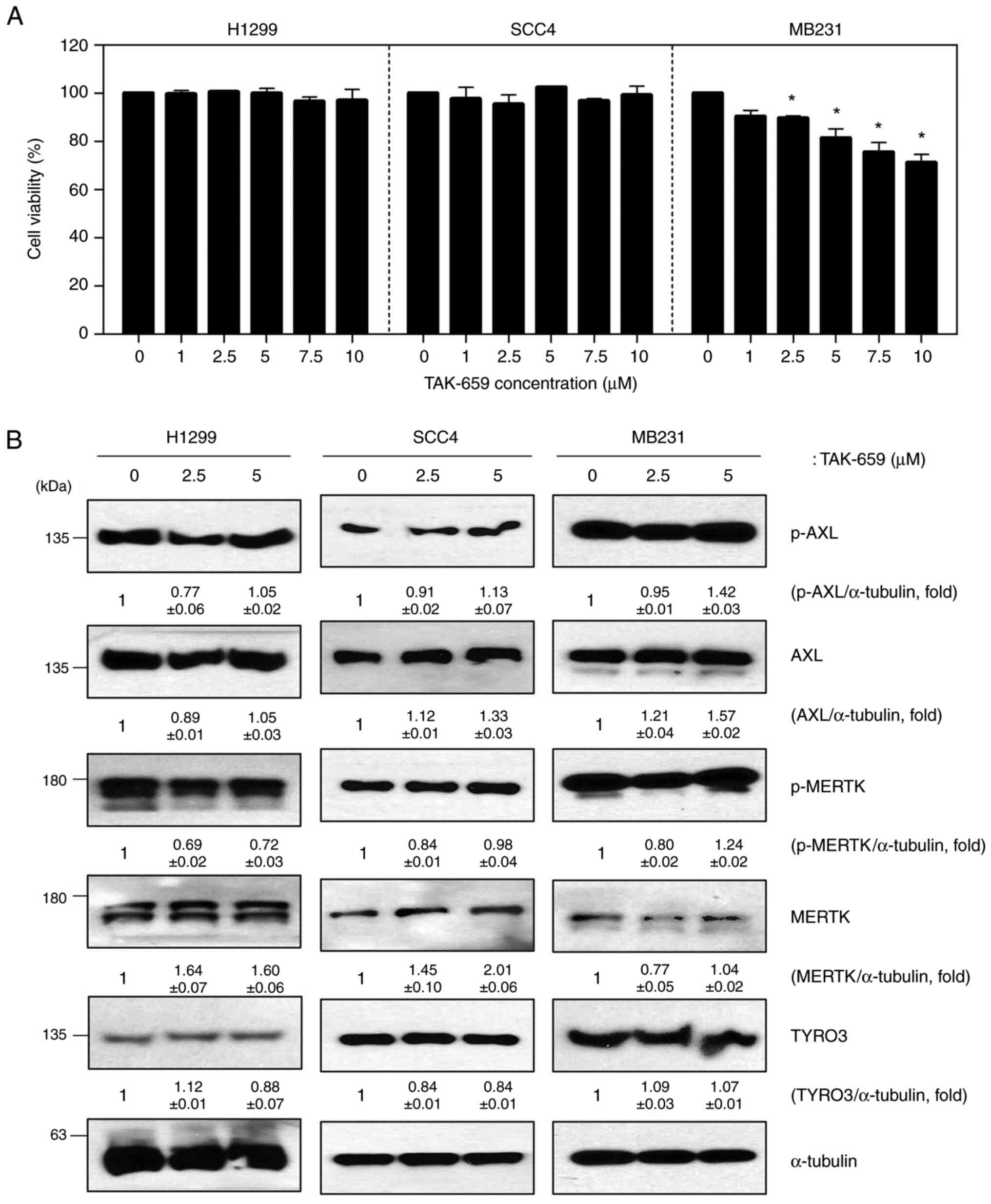|
1
|
Graham DK, DeRyckere D, Davies KD and Earp
HS: The TAM family: Phosphatidylserine sensing receptor tyrosine
kinases gone awry in cancer. Nat Rev Cancer. 14:769–785.
2014.PubMed/NCBI View
Article : Google Scholar
|
|
2
|
Wu G, Ma Z, Cheng Y, Hu W, Deng C, Jiang
S, Li T, Chen F and Yang Y: Targeting Gas6/TAM in cancer cells and
tumor microenvironment. Mol Cancer. 17(20)2018.PubMed/NCBI View Article : Google Scholar
|
|
3
|
Lemke G and Rothlin CV: Immunobiology of
the TAM receptors. Nat Rev Immunol. 8:327–336. 2008.PubMed/NCBI View
Article : Google Scholar
|
|
4
|
Cook RS, Jacobsen KM, Wofford AM,
DeRyckere D, Stanford J, Prieto AL, Redente E, Sandahl M, Hunter
DM, Strunk KE, et al: MerTK inhibition in tumor leukocytes
decreases tumor growth and metastasis. J Clin Invest.
123:3231–3242. 2013.PubMed/NCBI View
Article : Google Scholar
|
|
5
|
Paolino M, Choidas A, Wallner S, Pranjic
B, Uribesalgo I, Loeser S, Jamieson AM, Langdon WY, Ikeda F, Fededa
JP, et al: The E3 ligase Cbl-b and TAM receptors regulate cancer
metastasis via natural killer cells. Nature. 507:508–512.
2014.PubMed/NCBI View Article : Google Scholar
|
|
6
|
Werfel TA and Cook RS: Efferocytosis in
the tumor microenvironment. Semin Immunopathol. 40:545–554.
2018.PubMed/NCBI View Article : Google Scholar
|
|
7
|
Axelrod H and Pienta KJ: Axl as a mediator
of cellular growth and survival. Oncotarget. 5:8818–8852.
2014.PubMed/NCBI View Article : Google Scholar
|
|
8
|
Holland SJ, Pan A, Franci C, Hu Y, Chang
B, Li W, Duan M, Torneros A, Yu J, Heckrodt TJ, et al: R428, a
selective small molecule inhibitor of Axl kinase, blocks tumor
spread and prolongs survival in models of metastatic breast cancer.
Cancer Res. 70:1544–1554. 2010.PubMed/NCBI View Article : Google Scholar
|
|
9
|
Crittenden MR, Baird J, Friedman D, Savage
T, Uhde L, Alice A, Cottam B, Young K, Newell P, Nguyen C, et al:
Mertk on tumor macrophages is a therapeutic target to prevent tumor
recurrence following radiation therapy. Oncotarget. 7:78653–78666.
2016.PubMed/NCBI View Article : Google Scholar
|
|
10
|
Ludwig KF, Du W, Sorrelle NB,
Wnuk-Lipinska K, Topalovski M, Toombs JE, Cruz VH, Yabuuchi S,
Rajeshkumar NV, Maitra A, et al: Small-molecule inhibition of Axl
targets tumor immune suppression and enhances chemotherapy in
pancreatic cancer. Cancer Res. 78:246–255. 2018.PubMed/NCBI View Article : Google Scholar
|
|
11
|
Kim JE, Kim Y, Li G, Kim ST, Kim K, Park
SH, Park JO, Park YS, Lim HY, Lee H, et al: MerTK inhibition by
RXDX-106 in MerTK activated gastric cancer cell lines. Oncotarget.
8:105727–105734. 2017.PubMed/NCBI View Article : Google Scholar
|
|
12
|
Cummings CT, Zhang W, Davies KD,
Kirkpatrick GD, Zhang D, DeRyckere D, Wang X, Frye SV, Earp HS and
Graham DK: Small molecule inhibition of MERTK is efficacious in
non-small cell lung cancer models independent of driver oncogene
status. Mol Cancer Ther. 14:2014–2022. 2015.PubMed/NCBI View Article : Google Scholar
|
|
13
|
Gay CM, Balaji K and Byers LA: Giving AXL
the axe: Targeting AXL in human malignancy. Br J Cancer.
116:415–423. 2017.PubMed/NCBI View Article : Google Scholar
|
|
14
|
Zhang W, DeRyckere D, Hunter D, Liu J,
Stashko MA, Minson KA, Cummings CT, Lee M, Glaros TG, Newton DL, et
al: UNC2025, a potent and orally bioavailable MER/FLT3 dual
inhibitor. J Med Chem. 57:7031–7041. 2014.PubMed/NCBI View Article : Google Scholar
|
|
15
|
DeRyckere D, Lee-Sherick AB, Huey MG, Hill
AA, Tyner JW, Jacobsen KM, Page LS, Kirkpatrick GG, Eryildiz F,
Montgomery SA, et al: UNC2025, a MERTK small-molecule inhibitor, is
therapeutically effective alone and in combination with
methotrexate in leukemia models. Clin Cancer Res. 23:1481–1492.
2017.PubMed/NCBI View Article : Google Scholar
|
|
16
|
McDaniel NK, Cummings CT, Iida M, Hülse J,
Pearson HE, Vasileiadi E, Parker RE, Orbuch RA, Ondracek OJ, Welke
NB, et al: MERTK mediates intrinsic and adaptive resistance to
AXL-targeting agents. Mol Cancer Ther. 17:2297–2308.
2018.PubMed/NCBI View Article : Google Scholar
|
|
17
|
Rios-Doria J, Favata M, Lasky K, Feldman
P, Lo Y, Yang G, Stevens C, Wen X, Sehra S, Katiyar K, et al: A
potent and selective dual inhibitor of AXL and MERTK possesses both
immunomodulatory and tumor-targeted activity. Front Oncol.
10(598477)2020.PubMed/NCBI View Article : Google Scholar
|
|
18
|
Ekins S, Puhl AC, Zorn KM, Lane TR, Russo
DP, Klein JJ, Hickey AJ and Clark AM: Exploiting machine learning
for end-to-end drug discovery and development. Nat Mater.
18:435–441. 2019.PubMed/NCBI View Article : Google Scholar
|
|
19
|
Issa NT, Stathias V, Schurer S and
Dakshanamurthy S: Machine and deep learning approaches for cancer
drug repurposing. Semin Cancer Biol. 68:132–142. 2021.PubMed/NCBI View Article : Google Scholar
|
|
20
|
Gilson MK, Liu T, Baitaluk M, Nicola G,
Hwang L and Chong J: BindingDB in 2015: A public database for
medicinal chemistry, computational chemistry and systems
pharmacology. Nucleic Acids Res. 44 (D1):D1045–D1053.
2016.PubMed/NCBI View Article : Google Scholar
|
|
21
|
Kim S, Chen J, Cheng T, Gindulyte A, He J,
He S, Li Q, Shoemaker BA, Thiessen PA, Yu B, et al: PubChem 2019
update: Improved access to chemical data. Nucleic Acids Res. 47
(D1):D1102–D1109. 2019.PubMed/NCBI View Article : Google Scholar
|
|
22
|
Gaulton A, Bellis LJ, Bento AP, Chambers
J, Davies M, Hersey A, Light Y, McGlinchey S, Michalovich D,
Al-Lazikani B and Overington JP: ChEMBL: A large-scale bioactivity
database for drug discovery. Nucleic Acids Res. 40 (Database
Issue):D1100–D1107. 2012.PubMed/NCBI View Article : Google Scholar
|
|
23
|
Beck BR, Shin B, Choi Y, Park S and Kang
K: Predicting commercially available antiviral drugs that may act
on the novel coronavirus (SARS-CoV-2) through a drug-target
interaction deep learning model. Comput Struct Biotechnol J.
18:784–790. 2020.PubMed/NCBI View Article : Google Scholar
|
|
24
|
Choi Y, Shin B, Kang K, Park S and Beck
BR: Target-centered drug repurposing predictions of human
angiotensin-converting enzyme 2 (ACE2) and transmembrane protease
serine subtype 2 (TMPRSS2) interacting approved drugs for
coronavirus disease 2019 (COVID-19) treatment through a drug-target
interaction deep learning model. Viruses. 12(1325)2020.PubMed/NCBI View Article : Google Scholar
|
|
25
|
Connell NT and Berliner N: Fostamatinib
for the treatment of chronic immune thrombocytopenia. Blood.
133:2027–2030. 2019.PubMed/NCBI View Article : Google Scholar
|
|
26
|
Tanoli Z, Alam Z, Vähä-Koskela M,
Ravikumar B, Malyutina A, Jaiswal A, Tang J, Wennerberg K and
Aittokallio T: Drug target commons 2.0: A community platform for
systematic analysis of drug-target interaction profiles. Database
(Oxford). 2018:1–13. 2018.PubMed/NCBI View Article : Google Scholar
|
|
27
|
Liu T, Lin Y, Wen X, Jorissen RN and
Gilson MK: BindingDB: A web-accessible database of experimentally
determined protein-ligand binding affinities. Nucleic Acids Res. 35
(Database Issue):D198–D201. 2007.PubMed/NCBI View Article : Google Scholar
|
|
28
|
Zhou J, Cui G, Hu S, Zhang Z, Yang C, Liu
Z, Wang L, Li C and Sun M: Graph neural networks: A review of
methods and applications. AI Open. 1:57–81. 2020.
|
|
29
|
Elnaggar A, Heinzinger M, Dallago C,
Rihawi G, Wang Y, Jones L, Gibbs T, Feher T, Angerer C, Steinegger
M, et al: ProtTrans: Towards cracking the language of life's code
through self-supervised deep learning and high performance
computing. arXiv preprint arXiv: 200706225, 2020.
|
|
30
|
Ruder S: An overview of multi-task
learning in deep neural networks. arXiv preprint arXiv: 170605098,
2017.
|
|
31
|
Duan Q, Flynn C, Niepel M, Hafner M,
Muhlich JL, Fernandez NF, Rouillard AD, Tan CM, Chen EY, Golub TR,
et al: LINCS canvas browser: Interactive web app to query, browse
and interrogate LINCS L1000 gene expression signatures. Nucleic
Acids Res. 42 (Web Server Issue):W449–W460. 2014.PubMed/NCBI View Article : Google Scholar
|
|
32
|
Lamb J, Crawford ED, Peck D, Modell JW,
Blat IC, Wrobel MJ, Lerner J, Brunet JP, Subramanian A, Ross KN, et
al: The connectivity map: Using gene-expression signatures to
connect small molecules, genes, and disease. Science.
313:1929–1935. 2006.PubMed/NCBI View Article : Google Scholar
|
|
33
|
Subramanian A, Narayan R, Corsello SM,
Peck DD, Natoli TE, Lu X, Gould J, Davis JF, Tubelli AA, Asiedu JK,
et al: A next generation connectivity map: L1000 platform and the
first 1,000,000 profiles. Cell. 171:1437–1452.e17. 2017.PubMed/NCBI View Article : Google Scholar
|
|
34
|
Beitzen-Heineke A, Berenbrok N,
Waizenegger J, Paesler S, Gensch V, Udonta F, Vargas Delgado ME,
Engelmann J, Hoffmann F, Schafhausen P, et al: AXL inhibition
represents a novel therapeutic approach in BCR-ABL negative
myeloproliferative neoplasms. Hemasphere. 5(e630)2021.PubMed/NCBI View Article : Google Scholar
|
|
35
|
Yan D, Earp HS, DeRyckere D and Graham DK:
Targeting MERTK and AXL in EGFR mutant non-small cell lung cancer.
Cancers (Basel). 13(5639)2021.PubMed/NCBI View Article : Google Scholar
|
|
36
|
Markham A: Fostamatinib: First global
approval. Drugs. 78:959–963. 2018.PubMed/NCBI View Article : Google Scholar
|
|
37
|
Bussel J, Arnold DM, Grossbard E, Mayer J,
Treliński J, Homenda W, Hellmann A, Windyga J, Sivcheva L,
Khalafallah AA, et al: Fostamatinib for the treatment of adult
persistent and chronic immune thrombocytopenia: Results of two
phase 3, randomized, placebo-controlled trials. Am J Hematol.
93:921–930. 2018.PubMed/NCBI View Article : Google Scholar
|
|
38
|
Regan-Fendt K, Li D, Reyes R, Yu L, Wani
NA, Hu P, Jacob ST, Ghoshal K, Payne PRO and Motiwala T:
Transcriptomics-based drug repurposing approach identifies novel
drugs against sorafenib-resistant hepatocellular carcinoma. Cancers
(Basel). 12(2730)2020.PubMed/NCBI View Article : Google Scholar
|
|
39
|
Aehnlich P, Powell RM, Peeters MJW,
Rahbech A and Thor Straten P: TAM receptor inhibition-implications
for cancer and the immune system. Cancers (Basel).
13(1195)2021.PubMed/NCBI View Article : Google Scholar
|
|
40
|
Kasikara C, Davra V, Calianese D, Geng K,
Spires TE, Quigley M, Wichroski M, Sriram G, Suarez-Lopez L, Yaffe
MB, et al: Pan-TAM tyrosine kinase inhibitor BMS-777607 enhances
anti-PD-1 mAb efficacy in a murine model of triple-negative breast
cancer. Cancer Res. 79:2669–2683. 2019.PubMed/NCBI View Article : Google Scholar
|
|
41
|
Chen F, Song Q and Yu Q: Axl inhibitor
R428 induces apoptosis of cancer cells by blocking lysosomal
acidification and recycling independent of Axl inhibition. Am J
Cancer Res. 8:1466–1482. 2018.PubMed/NCBI
|
|
42
|
Lauter M, Weber A and Torka R: Targeting
of the AXL receptor tyrosine kinase by small molecule inhibitor
leads to AXL cell surface accumulation by impairing the
ubiquitin-dependent receptor degradation. Cell Commun Signal.
17(59)2019.PubMed/NCBI View Article : Google Scholar
|

















